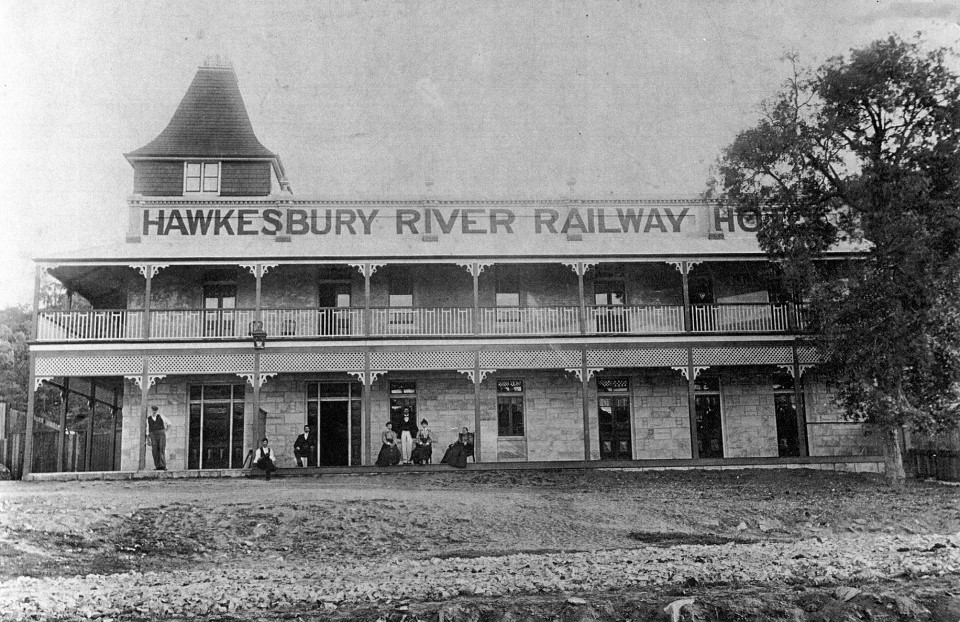SOME EARLY BROOKLYN PUBS
Brooklyn has been described, famously, as “a drinking village with a fishing problem.” The Angler’s Rest now stands as the sole survivor of a passing parade of watering holes that have refreshed railway navvies, fishermen, engine drivers, oystermen, tourist visitors and anyone else who has cared to drop in.
It all began with the decision to build a railway through this area. Brooklyn is in the centre of some of the most demanding pieces of railway construction in the State. The Cowan Bank descent from Cowan to the river is one of the steepest sections of railway in the system and its construction involved five tunnels, cuttings, embankments and massive earthworks over Salt Pan Creek.
It is amazing to think that these works took place using explosives, picks, shovels and transport by horse and cart. The work required huge numbers of navvies, who camped along the line, but particularly at the present site of Brooklyn Park and across the railway from the end of Hawkesbury Crescent. Many of the navvies had families who came with them. Some liked the area here and stayed to become long-term residents.
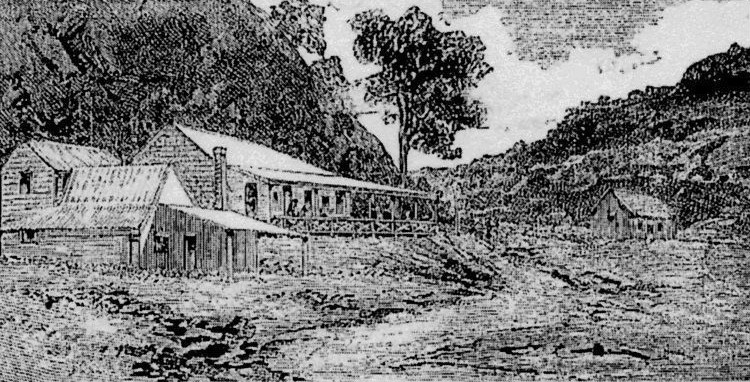
The navvies were thirsty and their supervisors and managers required better accommodation than the camps could provide. This meant that there was a great opportunity for hotels and inns. Many are now lost in the mists of time, but records show that Reid’s Inn was near the corner where Ross Street meets Brooklyn Road. It was probably a temporary building because the land on which it stood was only a three year lease, but it would have served the people at the main construction camp in the area now occupied by Brooklyn Park.
Further west along Brooklyn Road was the All Nations Hotel, owned by James Howard. It was a weatherboard building, once again not designed to remain permanently. The track up to the Red Gates Camp has now been formed into Hawkesbury Crescent. The construction of the bank over Salt Pan Creek was a huge task and some of the better paid employees probably stayed at the All Nations. The workers would come down after a day’s labour and the hotel was there to provide refreshment and company.
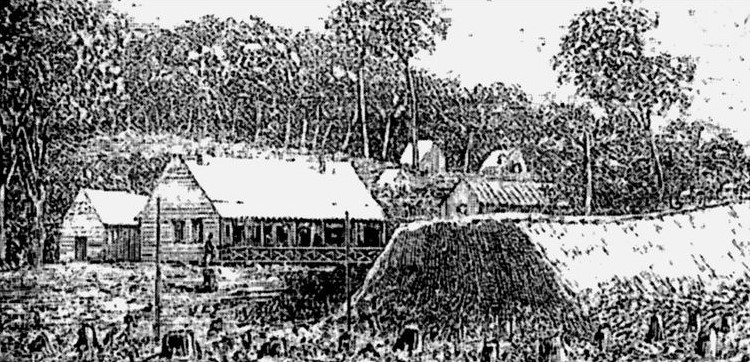
The All Nations Hotel was located opposite the modern site of Brooklyn Central Service Station. In the vicinity is a rock that carried engravings of some of the initials of the hotel’s clients. A third temporary hotel had special significance. Little is known about it, but a picture in the Town and Country Journal of 1884 shows Palmer’s Hotel.. From the picture, it seems that the hotel must have been roughly where the Health Centre now stands. It was a small pub, built to provide temporary service to the railway construction team. Little is known of Palmer’s Hotel, but it seems likely that the owner was Richard Palmer, whose name will feature prominently later in this account.
The temporary hotels all disappeared quickly after the railway was completed. A more permanent hotel outlasted them. It was the Brooklyn Hotel, with Joshua Everingham as the publican.
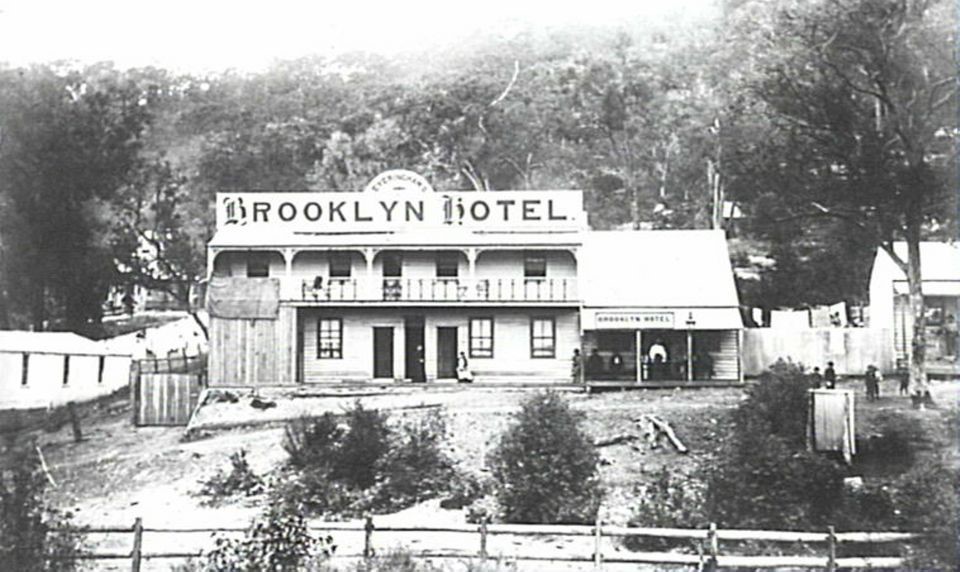
The Brooklyn Hotel was built on the site where Ambrose Reisch and Miriam Moloney now have their home. In fact, the foundation level of the old pub survived and the imprint of its roofline was stamped onto the wall of the Hang Gallery when fire destroyed it in the late 1920s.
The Brooklyn Hotel opened in 1884 and outlasted the railway construction period to become the first hotel to cater largely for the tourist trade. That trade was a good source of income because the railway had opened up a new pleasure area at Brooklyn. People came by train to fish, drink and enjoy the magnificent scenery. From 1887 to 1889, the railway bridge was being constructed and that, too, provided income from thirsty labourers.
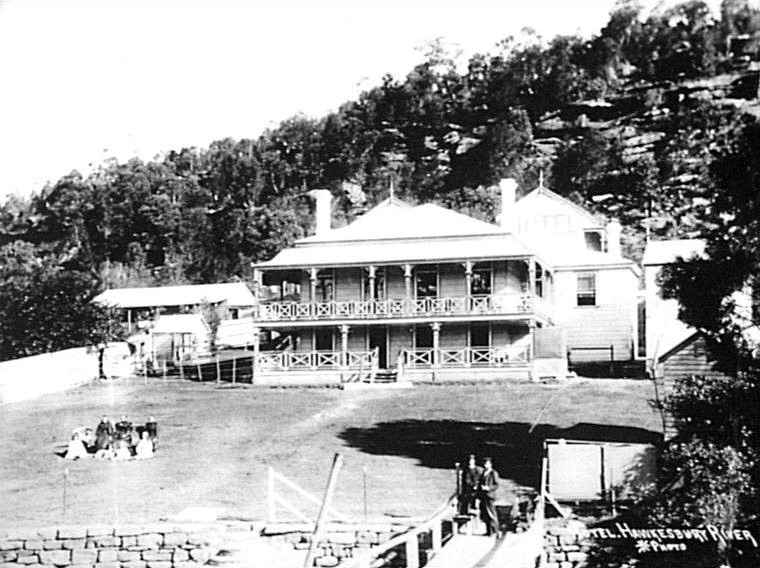
While the temporary hotels disappeared, there was soon strong competition as more permanent opposition to the Brooklyn Hotel appeared. In 1888, a large new hotel opened at the top of the hill above the modern location of Wharf Street, where Brooklyn on Hawkesbury apartments now stand. The hotel was originally named the Sanatorium Hotel.
The Sanatorium Hotel was quite a distance from the railway station and struggled from the start. Christopher Lenehan, the publican there in the early 1890s had to let the licence lapse ands applied for a wine licence instead.
The full licence was restored when Richard Palmer took over the hotel in 1898.
For some time during the 1890s, a licence was also granted to premises on Dangar Island. This was known as the Marine Hotel, or the Marine Club. Perhaps, however, it is opportune at this point to elaborate on the man, Richard Palmer, who made such as significant contribution to the drinking habits not only of people at Brooklyn, but across a wide section of Sydney.
RICHARD PALMER, COBB AND CO DRIVER

Richard Palmer was born in 1837, at St Albans on the Macdonald River. His parents kept a hotel there and he spent the first thirteen years of his life at St Albans before the family moved to Sydney. He left school at the age of thirteen and helped his father with a carrying business. After early experiences driving a horse-drawn hearse for an undertaker and a horse omnibus, Palmer went to the country. There his driving ability brought him an offer of employment as a driver for the famous Cobb and Co coach line.
He first drove the route from Mt Victoria to Bathurst, across tough mountain terrain, then switched to the run from Orange to Wellington. He moved to several other runs, including the New England area. His driving experiences included encounters with bushrangers, including being held up by the notorious Stapleton.
The life of a Cobb and Co driver was tough, Thomas, a widow. At about that time, Palmer gave up driving and turned to the hotel business. as he braved the weather and appalling road conditions. Palmer had married Julia Gutsel in 1857, but she died in 1875. In the same year, he remarried to Elizabeth At the time of Julia’s death, he was running the Rose of Denmark at Waterloo. Later interests included the Great Northern at Armidale, the Woolpack at Redfern and the hotel previously mentioned at Brooklyn. In 1886, he obtained conditional licence for the Royal Hotel at Chatswood. By 1889, he was publican at the Dungate Inn, on the corner of Liverpool and Castlereagh Streets, Sydney.

In 1891, Richard Palmer leased the Royal Hotel at Thornleigh for a period of eight years. At the end of this period, he returned to Brooklyn where he became the publican of the Sanatorium Hotel, which had struggled to provide a living up to that time. In July, 1898, Palmer successfully applied for a new licence for the hotel, which he renamed the Tourist’s Hotel.
Palmer had other plans, however. In January, 1899, he appeared at the Ryde Licensing Court seeking assurance that he could transfer the licence to a new hotel. He produced plans of a large brick building that he wanted to erect much closer to the village than the Tourist’s Hotel. He was told that he would have to build the new hotel and then apply for a new licence.
In April, 1899 newspapers reported that Mr Palmer was doing well in his hotel, but that a large hotel was to be erected by Cook’s Tourist Agency. This was the hotel that had been the subject of Palmer’s plans. In July, 1899, Palmer returned to the licensing court, seeking a conditional licence for a hotel with fifteen rooms, close to the station. The local policeman, Constable Doyle, opposed th application, but Palmer produced ten witnesses who all described the shortage of decent accommodation at Brooklyn. As many as forty at a time camped in Izzard’s boatshed and numbers even used spare railway carriages at the station. The plain fact emerging was that the Brooklyn Hotel, because of its location, had a much greater share of the tourist trade than Palmer’s Tourist’s Hotel. The new hotel would be in direct competition with the Brooklyn Hotel, but the Licensing Court agreed to grant the conditional licence.
By September, 1899, a newspaper was able to report that the foundation for the new hotel had been excavated. The building proceeded into 1900. Finally, on 3rd July, 1900, Richard Palmer appeared in the Licensing Court at Ryde to obtain confirmation of the conditional licence. Constable Doyle complained that there had been some variations from the plans, but the Bench agreed that they were actually improvements. Mr McNevin, the Police Magistrate, commented that the district was to be congratulated on having such a fine hotel on it.
Richard Palmer told the Licensing Court that he intended to trade under the name, The Hawkesbury River Railway Hotel.. By this time, the Palmers had made a name for themselves as great hosts. One can imagine Dick Palmer entertaining drinkers withy stories of his Cobb and Co days, while his wife had already given a splendid party at the Tourist’s Hotel in 1899. Her daughters, Eliza (aged 18), Gertrude (aged 16) and Beatrice (aged 13) were attractive young ladies and theri son, Alfred (aged 21) cut a handsome figure.
The new century saw the Palmers occupy the Hawkesbury River Railway Hotel, which still operates as the Anglers’ Rest...
THE HAWKESBURY RIVER RAILWAY HOTEL
